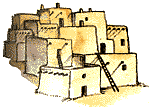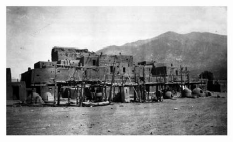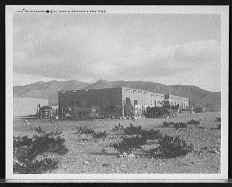|
|
|
|
Pueblo




The name given by the Spanish to the sedentary Native Americans who lived in stone or adobe communal houses in what is now the SW United States. The term pueblo is also used for the villages occupied by the Pueblo. Their prehistoric settlements, known as the Anasazi and Mogollon cultures, extended southward from S Utah and S Colorado into Arizona, New Mexico, and adjacent territory in Mexico. The transition from archaic hunters and gatherers to sedentary agricultural populations occurred around the first century a.d. , when maize, squash, and beans were widely adopted; the trio of foods is still used by the Pueblos. Although agriculture provided the bulk of the diet for these early populations, hunting and gathering was an important source of additional foodstuffs. Pottery manufacture began about a.d. 400 and was used for cooking and water storage. Clothing was woven from cotton, grown in warmer areas, and yucca fiber. Early houses among the Anasazi and Mogollon were pit houses, which were replaced by adobe and stone surface dwellings throughout the region by the end of the first millennium a.d.
Villages were variable in size and architectural content, but most included circular, often subterranean structures known as kivas (apparently a derivation of the pit house) and storage pits for grains. Prior to the 14th and 15th cent., densely settled villages were more the exception than the rule. Large pueblos were found at Chaco Canyon, dating to the 11th and early 12th cent., and at Mesa Verde, where multistoried cliff houses were inhabited in the 13th and 14th cent. Changing climatic conditions forced the abandonment of much of the region by the early 14th cent., with populations migrating to their present-day locations in the Rio Grande valley and a few other isolated areas (e.g., the Hopi mesas).
Language
The Pueblo speak languages of at least two different families. Languages of the Tanoan branch of the Aztec-Tanoan linguistic stock are spoken at 11 pueblos, including Taos, Isleta, Jemez, San Juan, San Ildefonso, and the Hopi pueblo of Hano. Languages of the Keresan branch of the Hokan-Siouan linguistic stock also are limited to Pueblo peopleWestern Keresan, spoken at Acoma and Laguna, and Eastern Keresan, at San Felipe, Santa Ana, Sia, Cochiti, and Santo Domingo. The Hopi language, which belongs to the Uto-Aztecan branch of the Aztec-Tanoan linguistic stock, is spoken at all Hopi pueblos except Hano. The Zui language may be connected with Tanoan, falling within the Aztec-Tanoan linguistic stock.
Social Structure
Among the modern Pueblo, men are the weavers and women make pottery and assist in house construction. The status of women among both the Western and the Eastern Pueblos is high, but there are differences related to the different social systems of each. The Western Pueblos, including the Hano, Zui, Acoma, Laguna, and, the best known, the Hopis, have exogamous clans with a matrilineal emphasis and matrilocal residence, and the houses and gardens are owned by women; the kachina cult emphasizes weather control, and the Pueblos who follow this cult are governed by a council of clan representatives. Among the Eastern Pueblos, there are bilateral extended families, patrilineal clans, and male-owned houses and land; warfare and hunting as well as healing and exorcism are more important than among the Western Pueblos.
The Spanish added new elements to the government in the form of civil officers, but the de facto government and ceremonial organization remained native. In recent years the Bureau of Indian Affairs introduced elected officials in Santa Clara, Laguna, Zui, and Isleta. The Hopi have an elected council on the tribal level. The Kachina and other secret societies dealing with war, agriculture, and healing still carry out their complicated rituals and dances: for some occassions, the public is invited. The reservation population in Arizona and New Mexico was just over 36,000 in 1980.
Contact with the Spanish
Initial contact with European populations came in the 16th cent., when Spaniards entered the Rio Grande area. The seven Zui towns were reported by the Franciscan Marcos de Niza to be the fabulous Seven Cities of Cibola, leading to the first intensive contactsa Spanish exploration party under Francisco Vsquez de Coronado in 1540. Due to increasing pressure on the existing food supplies, the initially friendly Pueblos became hostile and then revolted; their resistance ended in a mass execution of Native Americans by Coronado. In 1598 Juan de Oate began full-scale missionary work and moved the provincial headquarters of the Spanish colonial government to Santa Fe. By 1630, 60,000 Pueblo had been converted to Christianity, and 90 villages had chapels, according to Father de Benavides. Determined to put an end to the suffering caused by their Spanish oppressors, the Pueblos staged a successful revolt in 1680.
Pop, a medicine man, led a band of Pueblos which killed 380 settlers and 31 missionaries, and forced the remaining Spaniards to retreat to El Paso. However, the Pueblos lost 347 of their number in one attack on Santa Fe. Fearing Spanish reprisal, villages were abandoned for better fortified sites. In 1692 De Vargas, with the cooperation of some Pueblo leaders, reconquered the Pueblos in New Mexico. The Western Pueblos, however, including the Hopi, remained independent.
The Pueblo have the oldest settlements N of Mexico, dating back 700 years for the still occupied Hopi, Zui and Acoma pueblos. The Europeans who settled in the Southwest adopted the adobe structures and compact village plans of the Pueblos. The Pueblos, for their part, adopted many domestic animals and assorted crafts from the Old World, including blacksmithing and woodworking. See E. P. Dozier, The Pueblo Indians of North America (1970); Robert Silverberg, The Pueblo Revolt (1970); J. U. Terrell, Pueblos, Gods, and Spaniards (1973); A. Ortiz, ed., Handbook of Indians of North America: Vol. 9, Southwest (1979); L. Cordell, Prehistory of the Southwest (1984).
1400 Years of Pueblo Pottery
View some beautiful pieces of pottery here from the Pueblo tribes. They're
shown by age and tribal origin. The site is best viewed with MS Explorer.
http://www.indart.com/milborn/pots/home1.htm
Indian Pueblo Cultural Center
A broad overview first, then links to pages for 19 individual Pueblos, most
of whom have as many differences as similarities. Also, there are pages
concerning rules of etiquette and directions for visiting each Pueblo.
http://www.indianpueblo.org/
Pueblos
Not a big page, but an informative one, about New Mexico's 19 Pueblo tribes.
http://www.santafe.org/pueblos.html
tekayr's Home Page
A really attractive site here, chockful of information, with easy-to-read
text and logical progression in its layout. Topics covered so far are the
Hopi and Navajo nations.
http://www.geocities.com/Yosemite/Trails/1942/index.html
All Indian Pueblo Council - http://www.aipc-poep.com/page4.html
First recognized as a sovereign entity in 1598, the All Indian Pueblo Council is a consortium of the 19 Pueblo Indian tribes of New Mexico
Information about the Pueblo Indians - http://mo.essortment.com/pueblowherecan_riij.htm
Simple overview of the culture, history, way of life, and current situation of the Pueblo Indians.
New Mexico Indian Culture - http://www.newmexico.org/culture/indianculture.html
Overview of New Mexico's Pueblo cultures, their art and way of life.
Pueblo Cultural Center - http://www.indianpueblo.org/
Fact sheets on area Pueblo communities, calendar of events, online gift shop and education programs.
Tracing the Art of Pueblo Pottery - http://www.cmnh.org/research/cultural/pueblo-pottery/tracing.html
An excellent overview of Southwestern pottery, from the Cleveland Museum of Natural History.
Acoma Pueblo - http://www.indianpueblo.org/acoma.html
Overview of the Acoma Indians from the Pueblo Cultural Center.
Cochiti Pueblo - http://www.indianpueblo.org/cochiti.html
Brief overview of the Cochiti from the Pueblo Cultural Center.
Tracing the Art of Pueblo Pottery - http://www.cmnh.org/research/cultural/pueblo-pottery/cochiti.html
An article about contemporary Cochiti pottery.
Isleta Pueblo - http://www.indianpueblo.org/isleta.html
Overview of the Isleta Indians from the Pueblos Cultural Center.
Jemez Pueblo - http://www.newmexico.org/culture/pueblo_jemez.html
Tourism brief on the pueblo of the Jemez in New Mexico.
Jemez Pueblo - http://www.indianpueblo.org/jemez.html
Overview of the Jemez Indians from the Pueblos Cultural Center.
Laguna Pueblo - http://www.indianpueblo.org/laguna.html
Information about the Laguna Indians from the Pueblo Cultural Center.
Pueblo of Sandia Home Page - http://www.sandiapueblo.nsn.us/
Official page offers information on this Indian tribe's government, history, and culture, information about the casino, and the tribal newsletter.
Sandia Pueblo - http://www.indianpueblo.org/sandia.html
Information about the Sandia Indians from the Pueblo Cultural Center.
Taos Pueblo - http://www.indianpueblo.org/taos.html
Overview of the Taos Indians from the Pueblos Cultural Center.
The Taos Indians - http://nc.essortment.com/taosindian_rijr.htm
Article from PageWise. Opens new windows when you try to leave.
A:shiwi A:wan Museum and Heritage Center - http://www.nmculture.org/cgi-bin/showInst.pl?InstID=AISH
Hours, location, a calendar of events, and contact information.
A:shiwi Elementary School - http://www.zuni.k12.nm.us/aes/ashiwi.html
Homepage of this Zuni school with an online student newspaper and school projects.
Dowa Yalanne Elementary School - http://www.zuni.k12.nm.us/dy/default.html
Homepage of this Zuni Pueblo school includes staff and contact information.
The Berdache Tradition - http://www.breakaway.org/openstudio/sylviawhite/bertrad.htm
Discussion of the Zuni "lhamana," a ritualized transgender role, with a short biography of the famous lhamana We'wha.
The Inn At Halona - http://www.halona.com
Tribally licensed inn that is also an outlet for Zuni arts and crafts.
The Native American Hidden Ball Game - http://www.bluemountain.com/eng/nativeamer/cushing3.html
Description of a game played by the Zuni, made in 1883 by Frank Hamilton, an ethnologist from the Smithsonian.
The Zuni Man-Woman - http://www.geocities.com/WestHollywood/Stonewall/3044/zunibook.html
The story of We'wha, a Zuni lhamana (man raised as a woman) from the 19th century.
Zuni - http://www.curtis-collection.com/tribe%20data/zuni.html
Ethnography of this American Indian tribe by E.S. Curtis, with sepia photographs.
Zuni - http://kokopelliusa.com/zuni/zuni.html
Brief history of the Zuni, with an emphasis on their jewelry and fetish art.
Zuni and Hopi Kachinas - http://mn.essortment.com/hopizunikachin_rjpe.htm
Brief article on the sacred figures of these two tribes. Will pop up more windows when you try to leave.
Zuni Fetish Art - http://members.aol.com/zuniart/
From a merchant sales site, a description of Zuni fetish carvings with a virtual gallery. Pieces identified by artist.
Zuni High School - http://zuni.k12.nm.us/
Homepage of this New Mexico school, with student and teacher information.
Zuni Middle School - http://www.zuni.k12.nm.us/zms/index11.html
Homepage features student and teacher information and online student projects about the pueblo.
Zuni Tribe - http://wiwi.essortment.com/zuniindianwher_rieu.htm
Article by PageWise. Will open more windows when you try to leave.
Zui People - http://encarta.msn.com/find/Concise.asp?ti=04D30000
Encyclopedia article from MSN Encarta. |
|
|
|
|
|
 Native American Nations
Native American Nations
